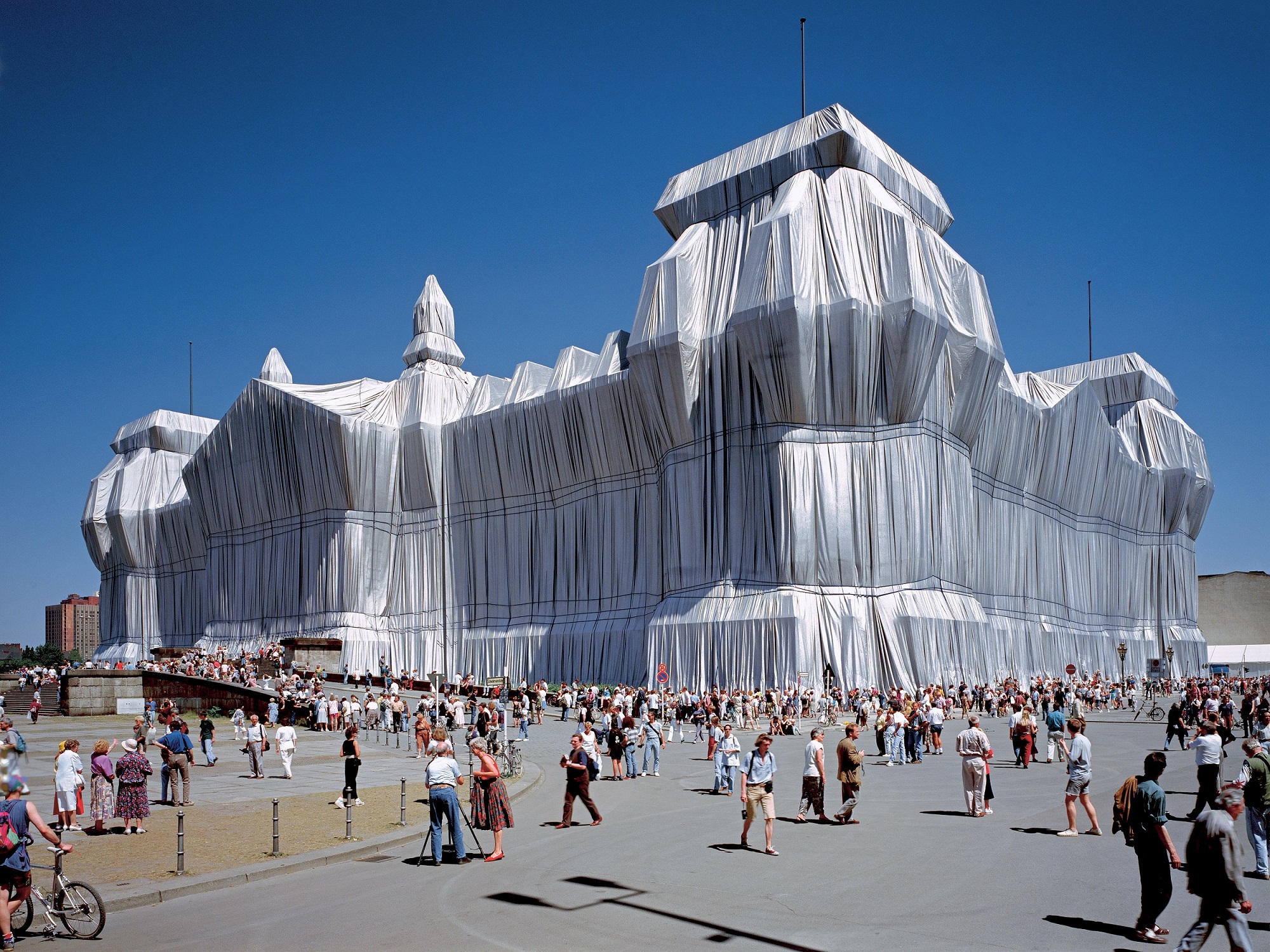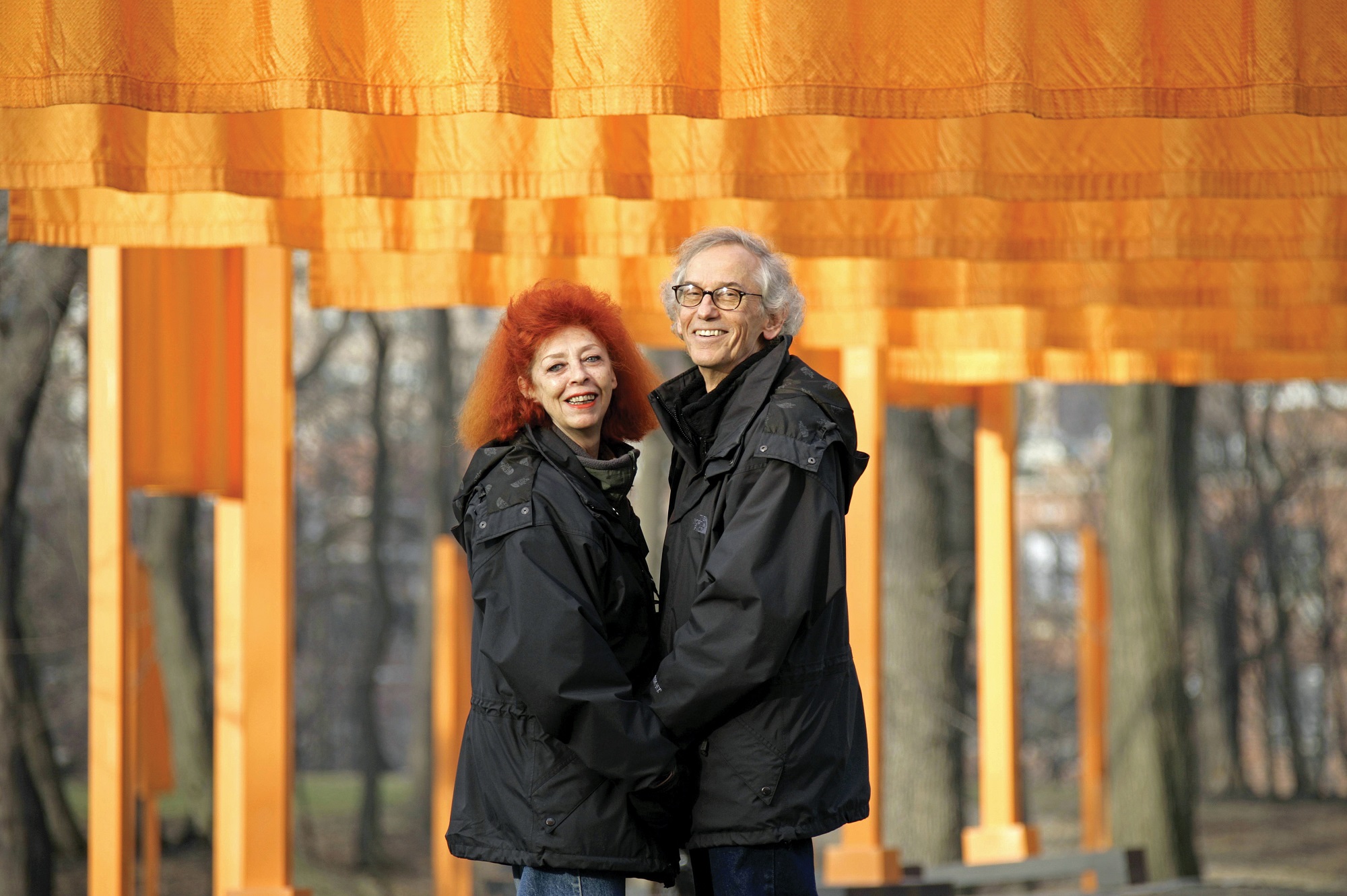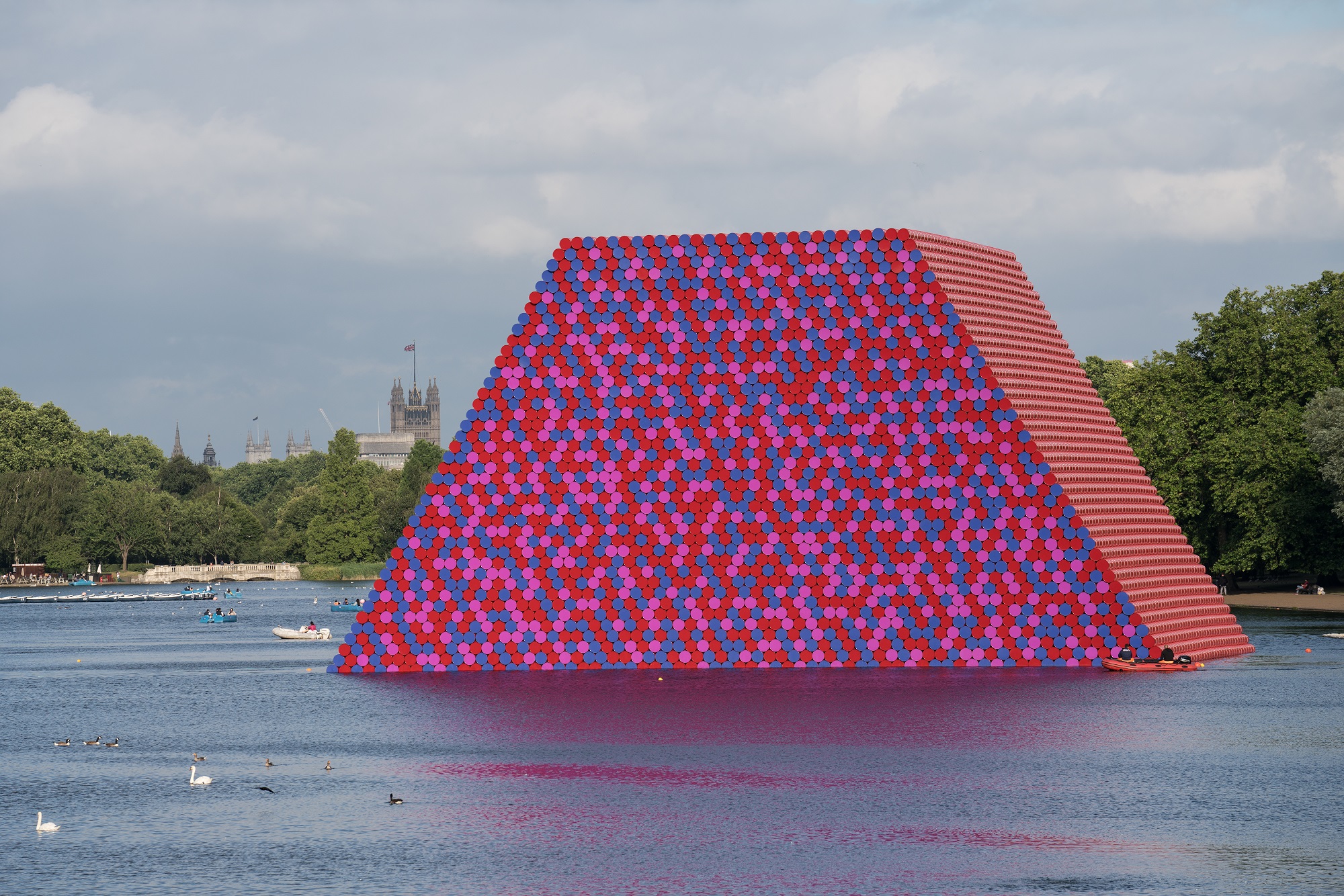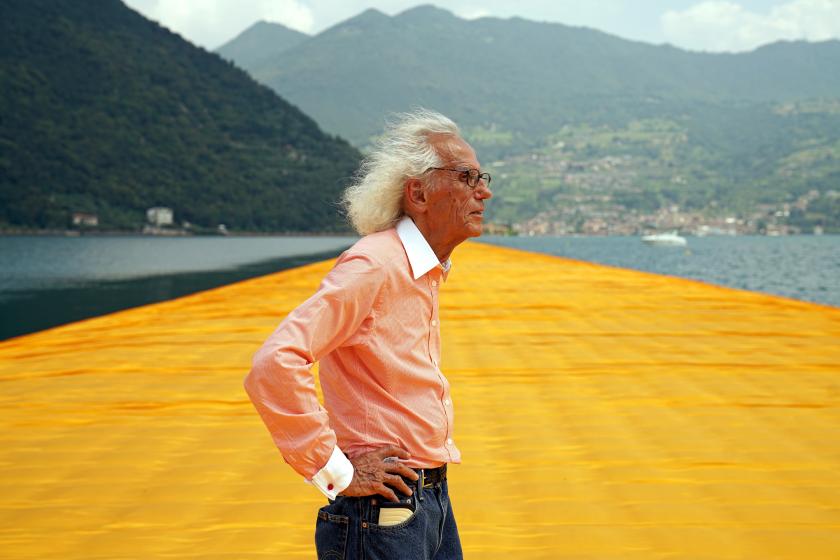The death of Christo, aged 84, was announced on Sunday, marking the end of a visionary and flamboyant artistic career. Best known for huge, ephemeral projects like the Wrapped Reichstag which stood for two weeks in June 1995, the American artist believed completely in the value of art for art’s sake, his vast, technically and logistically mindboggling creations brought into being for no purpose beyond their own existence.
Christo was born Christo Vladimirov Javacheff in communist Bulgaria in 1935, attending art school in Sofia before escaping to the west by bribing a customs officer when he was 21. Via Prague, Vienna and Geneva he arrived in Paris in 1958 where he met his lifelong partner Jeanne-Claude; their marriage a year later was followed in 1960 by the birth of their son, Cyril. Together, they would conceive and realise projects that transformed notions of sculpture and public art forever, Christo continuing alone after Jeanne-Claude’s death in 2009.
Early works anticipated the large scale wrapping of landscapes and buildings that would become their trademark, and in the 1950s Christo experimented with smaller objects like telephones and motorbikes, statues and women. The process of swathing objects in fabric and other materials developed ideas that had preoccupied generations of sculptors from the ancient Greeks to Henry Moore, whose famous shelter drawings, made during the Blitz in 1941, are an extended study of the clothed human figure.
 For Christo, wrapping an object facilitated what the art critic David Bourdon neatly summed up as "revelation through concealment”, emphasising certain physical characteristics, but also introducing mystery and vulnerability, as seen in the billowing contours of the Wrapped Reichstag (pictured above), the building’s heavy, neo-baroque proportions transformed into a fairytale palace. Art’s power to bridge the gap between reality and imagination has always been uppermost in the work of Christo and Jeanne-Claude, with yellow fabric unfurled across an Italian lake to allow people to walk on water (main picture), the islands in Biscayne Bay, Florida, surrounded with bubble-gum pink fabric, to become giant confections. If Christo and Jeanne-Claude made landscape their studio, they were always aware that it was never their plaything, however whimsical the project. In 1991, high winds made the umbrellas installed in a Japanese valley unsafe, killing a person and injuring others. Valley Curtain, installed between two Colorado mountains in 1972 lasted just 28 hours before a gale forced its removal.
For Christo, wrapping an object facilitated what the art critic David Bourdon neatly summed up as "revelation through concealment”, emphasising certain physical characteristics, but also introducing mystery and vulnerability, as seen in the billowing contours of the Wrapped Reichstag (pictured above), the building’s heavy, neo-baroque proportions transformed into a fairytale palace. Art’s power to bridge the gap between reality and imagination has always been uppermost in the work of Christo and Jeanne-Claude, with yellow fabric unfurled across an Italian lake to allow people to walk on water (main picture), the islands in Biscayne Bay, Florida, surrounded with bubble-gum pink fabric, to become giant confections. If Christo and Jeanne-Claude made landscape their studio, they were always aware that it was never their plaything, however whimsical the project. In 1991, high winds made the umbrellas installed in a Japanese valley unsafe, killing a person and injuring others. Valley Curtain, installed between two Colorado mountains in 1972 lasted just 28 hours before a gale forced its removal.
The first large scale wrapping project, Stacked Oil Barrels and Dockside Packages, Cologne Harbor, 1961, made from rolls of paper, oil barrels, tarpaulin and rope was also the first collaboration between Christo and Jeanne-Claude, and Jeanne-Claude’s indefatiguability would prove essential to the success of the couple’s increasingly ambitious projects, many of which, like Valley Curtain, were hampered by local opposition and bureaucracy. Diplomacy and logistics were Jeanne-Claude’s domain, about which she was never less than frank, explaining in an interview included in Antonio Ferrera’s 2010 film, Nomad of Art, that she had become an artist out of love for Christo: “I didn’t know anything about contemporary art”, she said “even less about avant-garde art. I was just in love with a young man who was in love with me.”
 Though Christo was always responsible for the design of the project, producing quantities of endlessly detailed drawings, the years or even decades of planning and preparation involved in a single project made logistics as much a part of the art work as the inevitably brief, if triumphant, end result. The Wrapped Reichstag took more than 20 years, and so though Jeanne-Claude died in 2009, works realised long after her death continue to be credited to her (pictured above: Christo and Jeanne-Claude, 2005). Their joint commitment to their art was such that they always took separate flights, so that if one of them should die, the other could continue their work. Even so, it would take until 1994 for Jeanne-Claude’s equal role in the collaboration to be fully acknowledged, at the insistence of Christo.
Though Christo was always responsible for the design of the project, producing quantities of endlessly detailed drawings, the years or even decades of planning and preparation involved in a single project made logistics as much a part of the art work as the inevitably brief, if triumphant, end result. The Wrapped Reichstag took more than 20 years, and so though Jeanne-Claude died in 2009, works realised long after her death continue to be credited to her (pictured above: Christo and Jeanne-Claude, 2005). Their joint commitment to their art was such that they always took separate flights, so that if one of them should die, the other could continue their work. Even so, it would take until 1994 for Jeanne-Claude’s equal role in the collaboration to be fully acknowledged, at the insistence of Christo.
The London Mastaba (pictured below), unveiled on the Serpentine in Hyde Park in June 2018, to coincide with a major retrospective exhibition at the Serpentine Galleries, was the pair’s first large scale project in London, and the partial fulfillment of a project that began as far back as the 1960s. Created from stacked oil drums, the massive floating structure took the form of a mastaba, a truncated trapezoid, and the Arabic word for bench. Massive as it was, the structure was a fraction of the size of the Abu Dhabi mastaba that has been in development since 1977, and which at 150m high and built from 410,000 steel barrels, was destined to be the largest permanent sculpture in the world.
Like fabric, oil barrels featured in Christo’s work as far back as the 1950s, when they were readily available in a yard next to his studio. Easy to stack, dismantle and rearrange, barrels proved an ideal material, and featured in Iron Curtain, a barricade installed across a Paris street in 1962, as a protest against the Berlin Wall that had been built the previous year.
 Though this seemed like an overtly political gesture, Christo and Jeanne-Claude have always denied any such significance in their work, refusing sponsorship of any kind and funding projects themselves in order to maintain artistic freedom. Similarly, they insisted that a work, once removed, must leave no trace on the landscape, with all materials being reused or recycled, and no long-term change made to the environment.
Though this seemed like an overtly political gesture, Christo and Jeanne-Claude have always denied any such significance in their work, refusing sponsorship of any kind and funding projects themselves in order to maintain artistic freedom. Similarly, they insisted that a work, once removed, must leave no trace on the landscape, with all materials being reused or recycled, and no long-term change made to the environment.
A statement issued on Sunday by the artists’ office confirmed that Christo died at home in New York City from natural causes, and concluded: “In a 1958 letter Christo wrote, 'Beauty, science and art will always triumph.' We hold those words closely today.”
A project to wrap the Arc de Triomphe in Paris is planned to go ahead, to be completed in September 2021 in accordance with the artists’ wishes, and later this year, an exhibition will open at the Centre Georges Pompidou about Christo and Jeanne-Claude's work and time in Paris.










![SEX MONEY RACE RELIGION [2016] by Gilbert and George. Installation shot of Gilbert & George 21ST CENTURY PICTURES Hayward Gallery](/sites/default/files/styles/thumbnail_125_x_125_/public/mastimages/Gilbert%20%26%20George_%2021ST%20CENTURY%20PICTURES.%20SEX%20MONEY%20RACE%20RELIGION%20%5B2016%5D.%20Photo_%20Mark%20Blower.%20Courtesy%20of%20the%20Gilbert%20%26%20George%20and%20the%20Hayward%20Gallery._0.jpg?itok=3oW-Y84i)




Add comment